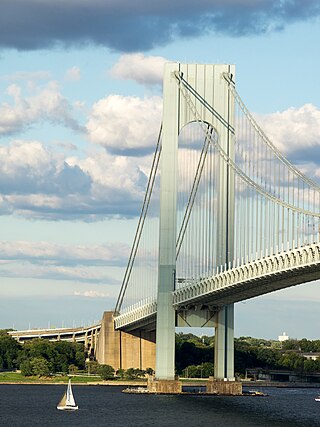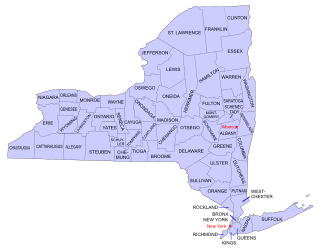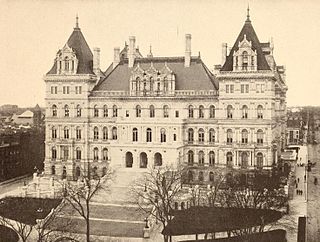
Staten Island is the southernmost borough of New York City, coextensive with Richmond County and situated at the southern tip of the U.S. state of New York. The borough is separated from the adjacent state of New Jersey by the Arthur Kill and the Kill Van Kull and from the rest of New York by New York Bay. With a population of 495,747 in the 2020 Census, Staten Island is the least populated New York City borough but the third largest in land area at 58.5 sq mi (152 km2); it is also the least densely populated and most suburban borough in the city.
In United States local government, a consolidated city-county is formed when one or more cities and their surrounding county merge into one unified jurisdiction. As such it is a type of unitary authority that has the governmental powers of both a municipal corporation and a county.

There are and have been several movements regarding secession from the U.S. state of New York. Only one of them – the state of Vermont – succeeded. Among the unsuccessful ones, the most prominent included the proposed state of Long Island, consisting of everything on the island outside New York City; a state called Niagara, the western counties of New York state; the northern counties of New York state called Upstate New York; making the city of New York a state; a proposal for a new Peconic County on eastern Long Island; and for the borough of Staten Island to secede from New York City.
The borough president are the chief executives of the five boroughs of New York City. For most of the city's history, the office exercised significant executive powers within each borough, and the five borough presidents also sat on the New York City Board of Estimate. Since 1990, the borough presidents have been stripped of a majority of their powers in the government of New York City.

John Joseph Marchi was an American attorney and jurist who represented Staten Island in the New York State Senate for 50 years. Marchi, a Republican, retired on December 31, 2006, from the seat that he had held since January 1, 1957. He was the Republican nominee for Mayor of New York City in 1969 and 1973.

The Boroughs of New York City are the five major governmental districts that compose New York City. The boroughs are the Bronx, Brooklyn, Manhattan, Queens, and Staten Island. Each borough is coextensive with a respective county of the State of New York: The Bronx is Bronx County, Brooklyn is Kings County, Manhattan is New York County, Queens is Queens County, and Staten Island is Richmond County.

The neighborhoods in New York City are located within the five boroughs of the City of New York. Their names and borders are not officially defined, and they change from time to time.
The West Bronx is a region in the New York City borough of the Bronx. The region lies west of the Bronx River and roughly corresponds to the western half of the borough.
The towns and cities of Downstate New York were created by the U.S. state of New York as municipalities in order to give residents more direct say over local government. Present-day Westchester, Bronx, New York, Richmond, Kings, Queens, Nassau, and Suffolk counties were part of York Shire from 1664-August 1673 and again from February 1674 until 1683 at which point the Province of New York was divided into counties. From August 1673 to February 1674 New York was under Dutch control and English political units were suspended, then restored under English rule. York Shire was divided into three divisions called ridings, the East, West, and North ridings. In 1683 the colony of New York eliminated shires and ridings in favor of counties, the East Riding becoming Suffolk County, West Riding the counties of Richmond and Kings, while the North Riding became the counties of Westchester, New York, and Queens.

The 121st New York State Legislature, consisting of the New York State Senate and the New York State Assembly, met from January 5 to July 16, 1898, during the second year of Frank S. Black's governorship, in Albany.

The 122nd New York State Legislature, consisting of the New York State Senate and the New York State Assembly, met from January 4 to April 28, 1899, during the first year of Theodore Roosevelt's governorship, in Albany.

The 123rd New York State Legislature, consisting of the New York State Senate and the New York State Assembly, met from January 3 to April 6, 1900, during the second year of Theodore Roosevelt's governorship, in Albany.

The 124th New York State Legislature, consisting of the New York State Senate and the New York State Assembly, met from January 2 to April 23, 1901, during the first year of Benjamin B. Odell Jr.'s governorship, in Albany.

The 125th New York State Legislature, consisting of the New York State Senate and the New York State Assembly, met from January 1 to March 27, 1902, during the second year of Benjamin B. Odell Jr.'s governorship, in Albany.

The 126th New York State Legislature, consisting of the New York State Senate and the New York State Assembly, met from January 7 to April 23, 1903, during the third year of Benjamin B. Odell Jr.'s governorship, in Albany.

The 127th New York State Legislature, consisting of the New York State Senate and the New York State Assembly, met from January 6 to April 15, 1904, during the fourth year of Benjamin B. Odell Jr.'s governorship, in Albany.

The 128th New York State Legislature, consisting of the New York State Senate and the New York State Assembly, met from January 4 to July 20, 1905, during the first year of Frank W. Higgins's governorship, in Albany.

The 129th New York State Legislature, consisting of the New York State Senate and the New York State Assembly, met from January 3 to May 3, 1906, during the second year of Frank W. Higgins's governorship, in Albany.









